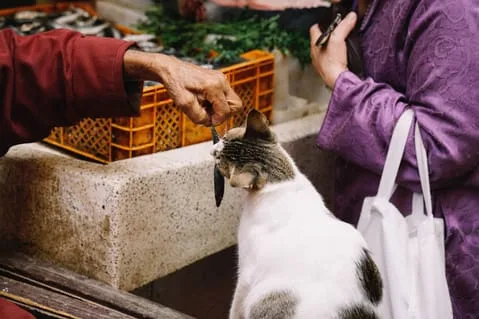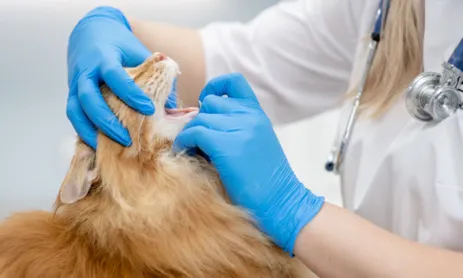Preventing Obesity in Cats

How to Help Your Cat Maintain a Healthy Weight
Overweight cats look cute in cartoons and memes, but feline obesity is no laughing matter. Excess weight strains your pet's heart and joints and increases the risk of diabetes, arthritis, urinary tract problems, cancer, and skin conditions.
Is Your Cat Overweight?
It's difficult to determine the ideal weight for your cat if you look at numbers alone. Although experts say cats should weigh between 7 to 12 pounds, some cats may be overweight or obese at 12 pounds, while others are sleek and slim.
A quick examination will help you evaluate your pet's weight. Run your hands over your pet's body. Can you feel the ribs or are they hidden under a thick layer of fat? The ribs are normally covered by a small amount of fat but can be felt easily if your cat isn't overweight. If you can't feel your pet's ribs, it may be time to make some changes to your pet's diet.
Take a look at your cat's waist from above while he or she is standing. You should see a slight indentation between the hips and back legs. A round appearance with no noticeable waist may mean that your cat is overweight or obese.
What You Can Do to Prevent Obesity
These steps can help your cat avoid the dangerous consequences of obesity:
- Offer Food Appropriate for Your Cat's Age. Your pet's nutritional needs change throughout his or her lifetime. Growing kittens require more frequent feedings and need extra nutrients in their food. Continuing to feed cats food intended for kittens past one year of age can lead to weight gain. Food changes may also be needed as your pet ages. Less active, older cats may benefit from lower-calorie senior food. Your pet's veterinarian can help you find a type of cat food that meets all of your pet's nutritional requirements.
- Pay Attention to Portion Sizes. Do you throw a handful of food in your cat's dish every time you notice it's empty? Overfeeding is a common cause of weight issues. In fact, your pet may only need one-third to one-half cup of food per day, depending on the food's calorie count. Take a look at the cat calorie calculator offered on the Pet Nutrition Alliance website to determine how many daily calories your cat really needs.
- Limit Treats. Too many treats can also affect your pet's weight and may be a factor in obesity. Treats should account for no more than 10 percent of your pet's daily caloric intake, according to the Cummings Veterinary Medical Center at Tufts University.
- Help Your Cat Stay Active. Cats need regular exercise to maintain their ideal weight and keep their hearts, muscles, and joints strong and healthy. Your cat may enjoy batting at the toy at the end of a kitty fishing rod, chasing a laser beam, or fetching a small toy. Interactive treat mazes offer physical and mental stimulation for your cat (as long as you pay attention to the calorie count of the treats), while battery-powered mice give your pet a fun workout. If you're handy, a homemade maze or climbing tower can keep your pet busy for hours.
- Visit the Vet. It's easy to overlook a slight weight gain in your cat. Unfortunately, even an extra pound may increase your pet's risk of developing health problems. During annual wellness exams, your pet's veterinarian evaluates your cat's weight and body condition and can offer a few healthy eating tips if your favorite feline has started to gain weight.
Approximately 60 percent of cats are obese, according to the American Association for Pet Obesity Prevention. Could your cat be one of them? If you're concerned about your cat's weight, contact our office to schedule an appointment here.
Pet Dental Care - Tips to Manage Your Pet’s Oral Health
Learn How to Improve Your Pet's Oral Health
How healthy are your pet's pearly whites? Without proper dental care, your furry friend may develop painful infections and even lose teeth. These tips will help you protect your pet's teeth and gums.
Brush Your Pet's Teeth
Brushing removes plaque, a clear bacterial film that constantly coats the teeth. Plaque is a factor in tooth decay, but unlike humans, dogs and cats rarely develop cavities.
Unfortunately, that doesn't mean that it's safe for plaque to remain on their teeth. Plaque turns into tartar if it's not removed within a week or two. Tartar, a hard, yellow deposit, irritates the gums and can cause inflammation and periodontal (gum) disease.
Daily brushing gets rid of plaque, preventing it from ever transforming into tartar. It's never too late to start brushing your cat or dog's teeth. Although it's easier to start brushing when your pet is a puppy or kitten, many older animals will eventually permit you to brush their teeth if you start the process gradually.
You may find brushing is easier if you:
- Let Your Furry Friend Lick or Smell the Toothpaste. Place a dab of pet toothpaste on your finger or a pet toothbrush and let your cat or dog sniff or lick it. Never use human toothpaste, as the ingredients can be toxic to animals. Pet toothpaste is a much better choice. The toothpaste contains flavors pets find appealing, like chicken, beef, seafood, and peanut.
- Rub Your Pet's Teeth. Once you've found a toothpaste flavor your pet likes, place a tiny amount on your finger and briefly rub the paste across the gums. Offering a treat when you're through may make teeth cleaning more acceptable to your pet. Keep in mind that you're not actually trying to clean your pet's teeth at this point. Rubbing the gums with the paste helps your furry friend adjust to the sensation of brushing.
- Try Brushing When Your Pet Is Comfortable. Squirt a pea-sized amount of toothpaste on a pet toothbrush or a finger brush, and gently brush your pet's teeth and gum line using a circular motion. Although both types of brushes remove plaque, a traditional toothbrush may be more effective in removing plaque at the gum line.
Patience is a must when you're starting an oral hygiene routine. It may take a week or two until you can progress from one step to another.
Month-Long Celebrations
- Pet Dental Health Month
- Dog Training Education Month
- National Cat Health Month
- Responsible Pet Owners Month
- Spay/Neuter Awareness Month (AKA Beat the Heat Month)
- Pet Dental Health Month
Week-Long Celebrations
- February 7–14: Have a Heart for Chained Dogs Week
- February 15–16: Westminster Kennel Club Annual Dog Show
- February 23–29: National Justice for Animals Week
Day Celebrations
- February 2: Groundhog Day
- February 3: Doggie Date Night
- February 3: National Golden Retriever Day
- February 14: Pet Theft Awareness Day
- February 14: Valentine’s Day
- February 15: President’s Day
- February 20: Love Your Pet Day
- February 22: Walking the Dog Day
- February 23: International Dog Biscuit Appreciation Day
- February 23: National Dog Biscuit Day
- February 25: World Spay Day
- February 25: Spay Day USA
- February 27: Polar Bear Day



